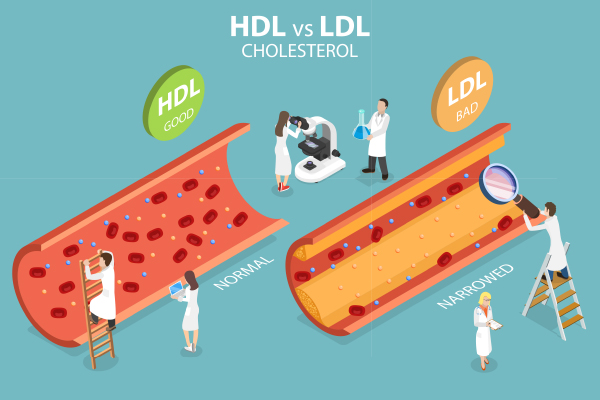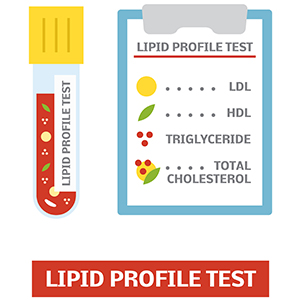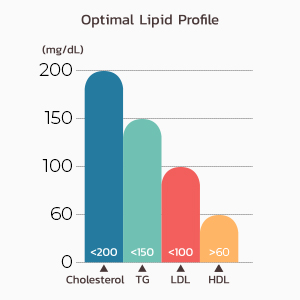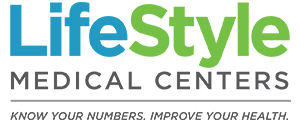The facts
about LDL

What is LDL?
Low-density lipoprotein (LDL) is a form of cholesterol, the “bad” type of cholesterol. Too much of this type of cholesterol in your blood causes the buildup of fatty deposits (plaques) in your arteries which reduces blood flow. If a plaque(s) ruptures, it can lead to a heart attack or stroke.
To understand more precisely what LDL is, we need to take a step back and look at what cholesterol is and the differences between good and bad cholesterol. We need to look at total cholesterol.
What is total cholesterol
Total cholesterol is the sum of your blood’s different types of cholesterol.
What is a cholesterol test (also known as a lipid profile)?
A cholesterol test (also known as a lipid profile, cholesterol panel, or a complete cholesterol test) is a blood test that measures the amount of cholesterol and triglycerides in your blood. Elevated total cholesterol levels are associated with increased risk of fatty deposits (called plaques) in the arteries throughout your body that can lead to atherosclerosis (narrowed or blocked arteries).
How common is high cholesterol?
About 38% of American adults have high cholesterol (total blood cholesterol ≥ 200 mg/dL) according to the Centers for Disease Control and Prevention.
What are the health risks of high cholesterol?
Too much cholesterol puts you at risk for stroke and heart disease, the two leading causes of death in the United States.
High cholesterol levels are a risk factor for coronary (heart) artery disease, heart attacks, and other forms of heart disease and diseases of the blood vessels.
At LifeStyle Medical Centers, you get the support, motivation, and accountability needed to set health goals and reach them.
We are an evidence-based lifestyle modification and medical nutrition therapy clinic, so we offer lab testing as a way to monitor your health.
The lab testing we offer include
In-house A1C and Lipid Panel
For tracking all the vital indicators that indicate your risk for major chronic diseases such as diabetes or heart disease
Body Composition
Advanced testing to truly understand your body’s composition of muscle, fat and fluids
How do I know if I have high cholesterol?
Unfortunately, there are no signs or symptoms of high cholesterol. The only way to know if you have it is to get your cholesterol checked. A complete cholesterol test is needed to determine your cholesterol and triglyceride levels. The test includes an assessment of the 4 types of fats present in blood:
- Total cholesterol. The sum of your blood’s cholesterol content.
- Low-density lipoprotein (LDL) cholesterol. This is the “bad” type of cholesterol. Too much of this type of cholesterol in your blood causes the buildup of fatty deposits (plaques) in your arteries which reduces blood flow. If a plaque(s) ruptures, it can lead to a heart attack or stroke.
- High-density lipoprotein (HDL) cholesterol. This is the “good” cholesterol because it helps carry away the LDL cholesterol, keeping arteries open and your blood flowing smoothly.
- Triglycerides. Triglycerides are a type of fat in the blood. When you eat, your body converts calories it doesn’t need into triglycerides. These are stored in fat cells. High triglyceride levels are often present if you are overweight, eating too many sweets, drinking too much alcohol, smoking, being sedentary, or having diabetes with elevated blood sugar levels.

How often do I need a cholesterol test (lipid profile)?
- Most healthy adults should have their cholesterol checked every 4 – 6 years at a minimum.
- Individuals who have heart disease, diabetes, or a family history of high cholesterol, should get their cholesterol checked more often and should talk with their healthcare provider for guidance.
- Children and adolescents should have their cholesterol checked at least once between ages 9 – 11 and again between ages 17 – 21 years or more or according to their healthcare provider’s recommendation.
- For men ages 45-65 and women 55-65, a lipid panel should be done every 1-2 years. Individuals over 65 should consider getting a test annually.
- If you have had an abnormal test, are taking cholesterol-lowering medications, or you’re at higher risk of coronary artery disease due to risk factors, more frequent testing than those recommended above may be needed.
What are the risk factors for high cholesterol?
Risk factors for high cholesterol include:
- A family history of high cholesterol or heart attacks
- Being Overweight
- Being physically inactivity
- Diabetes
- Poor diet
- Cigarette smoking
If you are already undergoing treatment for high cholesterol your regular testing will monitor the effectiveness of your treatments.
How do I prepare for a cholesterol test?
Most cholesterol tests require fasting prior to the test, consuming no food or liquids other than water, for nine to 12 hours before the blood draw. For this reason, the test is often done in the morning so you can fast overnight. There are some cholesterol tests that do not require fasting, so follow your provider’s instructions.
The test is a blood test with the blood being drawn from a vein, usually from your arm. An elastic band is wrapped around your upper arm to cause the vein in the arm to fill with blood. After the needle is inserted in a vein, a small amount of blood is collected into a vial or a syringe. Then the band is removed to restore circulation and blood will continue to flow into the vial until enough is collected. It’s a quick and relatively painless procedure.
What is a good cholesterol reading?
In the United States, cholesterol levels are measured in milligrams (mg) of cholesterol per deciliter (dL) of blood. To interpret your test results, use these general guidelines from the Mayo Clinic chart below and talk with your healthcare professionals for further clarification.

Total cholesterol |
|
| Below 200 mg/dL | Desirable |
| 200-239 mg/dL | Borderline high |
| 240 mg/dL and above | High |
LDL cholesterol (the bad type of cholesterol) |
|
| Below 70 mg/dL | Best for people who have coronary artery disease — including a history of heart attacks, angina, stents or coronary bypass. |
| Below 100 mg/dL | Optimal for people at risk of coronary artery disease or who have a history of diabetes. Near optimal for people with uncomplicated coronary artery disease. |
| 100-129 mg/dL | Near optimal if there is no coronary artery disease. High if there is coronary artery disease. |
| 130-159 mg/dL | Borderline high if there is no coronary artery disease. High if there is coronary artery disease. |
| 160-189 mg/dL | High if there is no coronary artery disease. Very high if there is coronary artery disease. |
| 190 mg/dL and above | Very high. |
HDL cholesterol (the good type of cholesterol)
|
|
|
Below 40 mg/dL, men Below 50 mg/dL, women |
Poor |
|
40-59 mg/dL, men 50-59 mg/dL, women |
Better |
| 60 mg/dL and above | Best |
Triglycerides (a fat found in blood)
|
|
| Below 150 mg/dL | Desirable |
| 150-199 mg/dL | Borderline high |
| 200-499 mg/dL | High |
| 500 mg/dL and above | Very high |
There are many steps to lowering cholesterol and the experts at LifeStyle Medical Centers can help
If your results show that your cholesterol level is high, there are many steps you can take to lower it. You might be able to lower your cholesterol with lifestyle changes, such as exercising, quitting smoking, and eating a healthy diet.
When lifestyle changes are not enough, cholesterol-lowering medications can help.
Call us at (919) 354-7077 or fill out this form and set up an appointment to determine your baselines.
Sources:
- Centers for Disease Control and Prevention, https://www.cdc.gov/.
- Mayo Clinic, https://www.mayoclinic.org/.
- Johns Hopkins Medicine, https://www.hopkinsmedicine.org/health.
- Cleveland Clinic, https://my.clevelandclinic.org/health/diseases.
